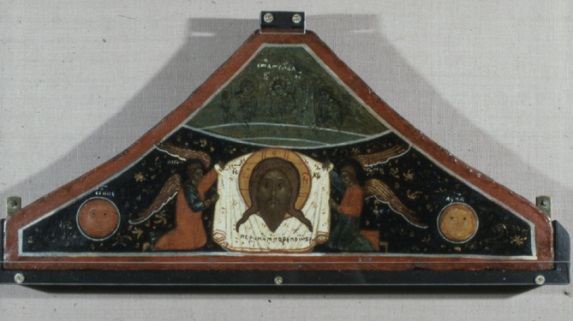
Unknown
Russian, Novgorod School
The Holy Face, 1500-1600, ca.
egg tempera on wood
8 1/2 x 19 in.
SBMA, Anonymous Donor
1961.41.1
COMMENTS
Description
This gable to a larger icon now missing, but probably a Crucifixion scene, exhibits the Mandylion (or “Image of the Savior Made Without Hands” being held by archangels Michael and Gabriel against a stellated, deep-blue background. Directly above the face of Christ, set against a light greenish background, is a representation of the Old Testament Trinity (identified in the upper inscription). At the left and right extremities of the gable appear the circular face of the sun (Solnitza) and the moon (Luna), thus identifying the location as a celestial one.
Origin and Iconography
Images of the Face of Christ on the Cloth were common by the 16th century in Constantinople, and became particularly popular after the arrival of the Edessa icon in the Byzantine capital in 944. However, the most memorable images of the type were painted by Russian icon painters.
The Old Testament Trinity refers to the three men who appeared to Abraham by the oak of Mambre (Genesis 18). Eusebius, the 4th century ecclesiastical historian, interpreted the event as God appearing to Abraham. From the 6th century the three men were represented as three angels to emphasize their heavenly origin and Trinitarian interpretation. The most famous painting of this old Testament Trinity was by the Russian monk Andrei Rublëv in the early 15th century. His great masterpiece was often copied by subsequent iconographers. The Santa Barbara icon, however, is not based on Rublëv’s version. All three angels point down at the Mandylion. The central angel is identified as Jesus Christ both by the cruciform halo and the abbreviations IC XC. The two symbolize God the Father and the Holy Spirit. All three appear as outline drawings behind a slightly curved table.
- Robert Henning, Jr., "Russian Icons in Santa Barbara," Santa Barbara Museum of Art, 1982
Bibliography
Lazarev, Moscow School of Icon-Painting, Moscow, 1971, pp, 23-26, pls. 35-38.
McKenzie, A.D., Greek and Russian Icons, Milwaukee, 1966, pl. 3 and pp. 23-24.
Onasch, K. Icons, London, 1961, pls. 30, 98-101, pp. 349 & 386.
Ouspensky, L. and Lossky, V. The Meaning of Icons, 1952, pp. 202-207.
A. Voyce, The Art and Architecture of Medieval Russia, Oklahoma, 1967, p. 349 & pls. 122-25.
SBMA CURATORIAL LABELS
The Slavonic inscription on this panel translates as: "The Image of Our Lord and God on the Cloth". The painting shows a piece of textile on which the face of the living Jesus Christ was miraculously imprinted. The original was most probably destroyed in the thirteenth century, but painters continued reproducing it on the basis of earlier models.
- Religious Images of the Christian East, 2013
